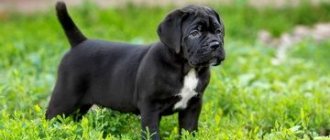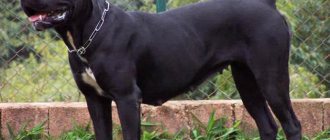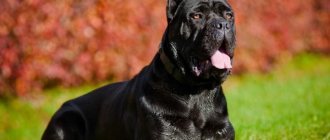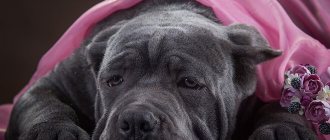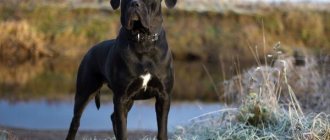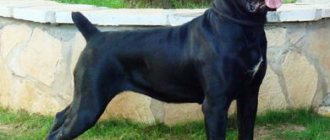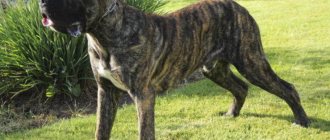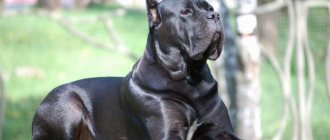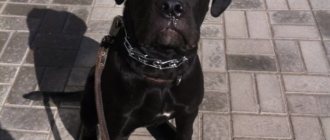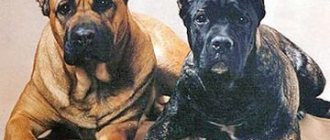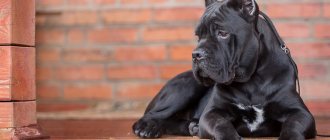Today, the Cane Corso standard is dictated by a document from the FCI, the Federation Cynologique Internationale, which came into force on January 1, 2016. It is not that much different from the previous one, but when searching for information, do not forget that you may stumble upon outdated information.
In this article we will talk in detail about the standard of this dog breed that is in force today, we will try to highlight important nuances and answer questions that often worry Cane Corso Italiano owners. All this will come in handy even if you do not intend to raise your puppy into a champion dog.
BREED STANDARD CANE CORSO
FCI-Standard N° 343 / 06.06.2007/
ORIGIN: Italy.
PUBLICATION DATE OF ORIGINAL VALID STANDARD: 11/13/2015
APPLICATIONS: Working dog, various uses.
FCI CLASSIFICATION:
- Group 2. (Pinchers and Schnauzers, Molossians, Swiss
- Mountain and cattle dogs, other breeds).
- Section 2.1. (Dogs like Molossers and Mastiffs).
- With performance tests.
Afterword: A dog can change
All owners of young Cane Corsos should not give up on their pet if suddenly some part of its body does not meet the required parameters. Remember that dogs of this breed, like all Molossians, develop slowly.
The animal will be fully formed only after its third birthday, and before that it will still stretch out, mature, and mature psychologically. Therefore, if you wanted to go to an exhibition with a two-year-old handsome dog, but he was rejected there, do not despair, but try later, when the dog reaches, as they say, its prime.
Also keep in mind that no animal, including world champions, is perfect. Dogs that win competitions also have their disadvantages, but their advantages simply outweigh them.
That's why it's important to know what's great about your Cane Corso and what's not so great, so you can show off the positives.
When choosing a puppy, do not skimp if the quality of the animal is important to you, no matter how pragmatic it may sound. At one time, Cane Corso suddenly became fashionable, and everyone and anyone was too lazy to take up their breeding. Naturally, the purity of the breed and the appearance of the dogs suffered.
If you want to have a healthy, beautiful, purebred pet, a real Cane Corso Italiano, buy puppies only from well-known, well-established nurseries. Better to pay more. Cheap and high quality may happen, but not in this case.
Did you like the article? Show it off by liking it. Or maybe you and your pet have participated in exhibitions and competitions, or are you just planning to? Share your experience and opinion in the comments. They will certainly be of interest to other Cane Corso lovers.
FACIAL PART
Nose: The nose is black. If there is a gray mask on the muzzle, the nose can match the color of the mask. The nose is large, with large and well-opened nostrils, in line with the bridge of the nose.
Muzzle: Powerful, square, noticeably shorter than the skull, the proportion muzzle: skull is approximately 1:2. The front of the muzzle is flat, the lateral surfaces are parallel, the length of the muzzle is equal to its width. When viewed from the side, it is deep. When viewed from the side, the bridge of the nose is straight.
Lips: The upper lips, when viewed from the front, have an inverted U pattern, and where they meet, when viewed from the side, the lips droop slightly. They cover the lower jaw and form the lower profile of the muzzle.
Jaws/Teeth: The jaws are large, powerful and curved. A standard bite is a small underbite, not exceeding 5 mm. A level bite is acceptable but not desirable.
Cheekbones: Chewing muscles are well developed, but do not protrude.
Eyes: Medium size, slightly protruding, never protruding; oval in shape, set straight and wide. The eyelids are tight fitting. The color of the iris of the eyes is as dark as possible, depending on the color of the coat. The look is lively and attentive.
Ears: Triangular, drooping, medium size. Set wide apart and much higher than the zygomatic arches. The ears are not cropped.
Neck: Strong, muscular, neck length equal to head length.
Docking a dog. Pros and cons
Separately, it is worth mentioning about the ears. Previously, most Cane Corso owners docked them. Today, in different countries of the world, thanks to Greenpeace, this operation is prohibited, and dogs with cropped ears or tails are not allowed to compete there.
The ban is now spelled out in the new standard, unlike the previous one. Previously, it was allowed to crop ears in the form of an equilateral triangle, but now the requirements are different: the ears must be natural, triangular, hanging as nature intended. They are medium in size and stand high and wide on the head.
Since the operation now contradicts the international standard, “shortened” Cane Corso dogs are not welcome in Russia either. After the release of the new standard, the Russian Cynological Federation published its explanation of it. It says that in countries where docking is prohibited by law, dogs with cropped tails and ears should not be allowed to compete, this is logical.
But where such a rule does not apply, judges should not “reject” a competitor with a docked tail or ears, despite the FCI standard. The standard in this regard does not apply to puppies born before January 1, 2016, that is, before the publication of the document.
Today, most Russian professionals do not recommend this operation.
Regarding the tail, the old standard stated that it was cut off at the level of the fourth vertebra. According to the new document, it should be of natural length, with a very thick “spine”, the fit is high, but the tail does not stand up and in no case curls into a “donut”.
By the way, the tradition of cutting dogs’ tails and ears dates back to the times when they constantly participated in hunting or fighting. The operation was performed so that the dog had fewer vulnerable spots, because it was the tail and ears that suffered the most during various battles and brawls.
Nowadays, this is no longer important, and many recognize the tradition as inhumane, even cruel. Proponents of cropping have their own argument - cropped dog ears are supposedly less susceptible to infections. However, there is no absolute certainty here and the benefits of this operation have not been proven.
Docking is still sometimes done on hunting or fighting dogs to reduce the likelihood of tail fractures. There is also an interesting observation: some dog breeders say that puppies with docked tails are slightly behind in development from their “natural” peers. But the fact has not been studied and still requires confirmation.
SERIOUS DISADVANTAGES/DEFECTS
- The upper longitudinal lines of the skull and muzzle are parallel or converge at too great an angle.
- The zygomatic arches are overdeveloped.
- Partial depigmentation of the nose.
- Scissor bite, overshot more than 5 mm.
- Tail curled into a ring or set vertically.
- Trot alternating with ambling.
- Height above or below the standard.
- Presence of dewclaws.
Dog body parameters
The documents clearly define the parameters for each part of the dog’s body and even its character. So that you have a general idea, we will first give them briefly, and then consider each point in more detail and talk about the possible shortcomings and vices of the Corso.
The ideal representative of the breed must fit all the given parameters and have:
- correct proportions of the body and head; - good teeth and bite; - flexible, friendly character; - healthy gait with wide strides; - suitable height and weight; — the desired color is one of those included in the standard.
For mating, knowledgeable dog breeders take only those representatives who meet all the requirements of the standard.
Let's consider all the points in detail, because everywhere there are nuances and reservations, and the approach to dogs at various competitions can be contradictory.
DISQUALIFYING FAULTS
- Aggression or cowardice.
- Any dog clearly showing physical or behavioral abnormalities must be disqualified.
- The upper longitudinal lines of the skull and muzzle are divergent.
- Complete depigmentation of the nose.
- The bridge of the nose is arched or humped (mutton nose, Roman nose).
- Underbite.
- Complete or partial depigmentation of the eyelids; whitish eyes (interspersed with blue spots); strabismus.
- Tailless, short tail.
- The coat is semi-long, cropped or fringed.
- All colors not provided for in the standard; large white spots.
Body and paws
The body of the Cane Corso, according to the norms, is built strongly. The neck is quite thick, powerful, the same length as the head, and dry. If there is dewlap (sagging skin) at the bottom of the neck, this is no longer the norm. The dog's withers are clearly visible and stand above the croup, which, in turn, is slightly inclined, wide, but elongated.
The Corso's loin is short in comparison with the back, straight and very strong, equal to approximately 20% of the dog's height at the withers. The chest stands out noticeably in the silhouette of the dog. It should also be strong, powerful, well and evenly developed.
The front paws in the toe area are cat-like. The pasterns are slightly inclined, elastic, the wrists are flexible, the forearms are very strong and straight. The paws should not be turned towards each other (clubfoot) or in different directions (splayfoot).
The Cane Corso's shoulders are also strong, the shoulder blades are sloping, they are long and the muscles on them are noticeably well developed.
The hind legs are not so compact, with wide, long thighs, the rear line of which protrudes. The shins are dry, strong, the knee and hock joints have a slight angle. The hocks are powerful and sinewy. In general, when looking at the dog from behind, the legs should appear straight. Paws with a “broom” or a wheel are unacceptable for this breed.
Important: in male dogs, both testes must be fully developed and descended into the scrotum.
Pay attention to both the animal’s gait and how it runs. The Cane Corso's stride should be wide, and when running it should be a sweeping, brisk trot.
Origin story
The ancestors of the breed are Molossian dogs. In ancient times, Cane Corsos served as guards, took part in battles and military operations, and tended herds. As time passed, firearms began to be used in battles, and the need for military dogs disappeared. Already at the beginning of World War II, the number of animals decreased significantly.
Today Italians call the Cane Corso their pride. However, despite its cultural and historical significance, the breed was on the verge of extinction even in Italy. It was preserved by a group of enthusiasts who went in the 70s of the last century to look for preserved individuals to where the breed originated - to Locatia, Puria, Sicily.
They managed to preserve the ancient beauty. The breed was officially recognized by the Italian Canine Association in 1994, and in 1996 by the international organization FCI. In 1999, the Association of Italian Cane Corsos was founded. The standard was adjusted and came into force in 2003. It is still used today by the International Cane Corso Federation.
Health
On average, Cane Corsos live up to 11 years. They are naturally strong, the health of these Roman Molossians is good, but a predisposition to certain diseases is still observed:
- Hip dysplasia is a pathology that is inherited.
- Elbow dysplasia is a disorder of the development of joint structures.
Read about hip and elbow dysplasia in our article: Joint dysplasia in dogs: a weak point of large breeds
- Cardiovascular diseases.
- Entropion - characterized by abnormal position of the eyelids (upper, lower or both). This disease is also called entropion.
- Eversion of the eyelid is a pathology in which the conjunctival surface of the eyelid is turned outward. If left untreated, blindness may occur.
- Stomach bloating is a dangerous condition that can be fatal within just a few hours.
- Epilepsy develops after stress, but this is not the only cause of the disease. Purebred animals, including corsas, are particularly predisposed to the disease.
The health of a dog depends entirely on nutrition and maintenance, in other words, on the owner. The owner must carry out vaccinations and preventive examinations and x-rays on time. At the first signs of illness, immediately contact a veterinarian, excluding self-medication.
Care
Shedding is not intense, but hair falls out constantly, so you will need a special rubber mitten. Water treatments are indicated when the corso becomes dirty or smells unpleasant. It is advisable to avoid the bath in winter, especially in the presence of drafts; you can use dry shampoo from a veterinary pharmacy.
The eyes and ears should be examined for infections. The claws usually wear down on their own during active walks, but if they grow, the plates can become deformed, grow in, and cause pain. You need to get used to using a nail clipper gradually.
Opinions about brushing your teeth vary. As a rule, if you choose specialized treats and toys, there will be no plaque left. Sometimes you can treat yourself to a piece of fresh tomato to remove protein residues from your teeth. If cleaning is still necessary, first let the paste taste. Only a veterinarian can remove tartar.
What to feed
The Cane Corso's diet should be tailored to the pet's activity and age. It must be balanced. This is achieved in different ways. Typically, owners opt for either natural feeding or buy ready-made food.
It is important that the bowl of food is placed at chest height, and that the pet does not bend over while eating. You can’t leave food in the bowl after eating; from puppyhood, the animal needs to be taught order.
Puppy diet
Starting from 3 weeks of age, the puppy is accustomed to a normal feeding diet. You need to create a feeding schedule for your puppy. Babies are given food 3–6 times a day, gradually transferring puppies to the 2 meals a day diet of an adult dog. The portion is determined individually by observing behavior. If the puppy eats everything and calmly goes to his place, then the amount of food is suitable for him. If after feeding the puppy's belly is swollen and lethargic, it means he has overeaten.
Protein food
Suitable protein sources:
- lean meat (veal, beef, chicken, rabbit);
- fish (preferably sea fish, river fish may contain helminth eggs);
- cottage cheese;
- eggs;
- milk.
Until 10 weeks of age, food is crushed. Raw beef or veal meat is scraped, boiled chicken and rabbit are ground in a blender. It is useful to give puppies the blood of slaughter animals (from 2–3 months). Meat products are introduced into the diet from 5–6 months of age. When changing teeth, young dogs are given beef bones. Meat is added at every feeding. It is combined with vegetables and cereals.
Fish should be given carefully. No need to mix it with meat
It is better to alternate meat meals with fish. To do this, all the bones are removed from the fish, the river species are boiled, the sea species can be given raw, everything is crushed. It is given 1-2 times a week to puppies from 4 months.
Raw eggs are given to puppies along with other food, while protein is completely excluded from the diet. The yolk can also be given boiled. Milk is good for puppies. It is given raw or porridge is cooked on it. From time to time, milk can be replaced with curdled milk. It is useful to give non-acidic cottage cheese.
Sources of fats
Cane Corso puppies need animal and plant fats. Their sources may be:
- milk, sour cream;
- butter;
- vegetable oils;
- beef fat.
The daily fat intake for puppies up to one year is 2.6–2.7 g per 1 kg of animal weight. Fats are added to cereals, vegetables, and mixed with lean meat. With a lack of fat, puppies are stunted in growth. Excessive consumption of fatty foods can lead to disruption of certain functions, causing the animal to become inactive and lethargic.
Carbohydrate foods and vitamins
For normal development, puppies need sugar, fiber, and starch. These substances are contained in:
- cereals (pearl barley, wheat, buckwheat, oatmeal, semolina, barley, corn, rice);
- bread, bran;
- vegetables (carrots, beets, cabbage);
- fruits and vegetables;
- honey
The puppy's daily diet should include 15–16 g of carbohydrates per 1 kg of the puppy's weight. To feed Cane Corso puppies 2 months old, cereals are crushed and brewed with hot milk. After cooling, feed it to the puppies. Starting from 4 months, Corso puppies are given cut. Whole grains are suitable for dogs aged 6 months and older.
You need to be careful with oatmeal. It is given once a week
Addiction to this product provokes inflammation of the anal glands. Legumes are not suitable for them either. They are poorly digestible by both puppies and adults. The exception is soy; it can be added in crushed form to porridge and vegetable salads.
Adult dog diet
The diet of an adult dog is not very different from the diet of a puppy. It's all about the amount of food. An adult Cane Corso requires 20–40 g of dry food per day (depending on body condition) and 30–60 g of liquid food with a significant water content.
The diet largely depends on how the dog is used. Service dogs need more energy, which means they will also need more proteins/fat/carbohydrates.
An animal weighing 50 kg should consume daily:
- 220–230 g proteins;
- 60–70 g fat;
- 460–470 g carbohydrates;
- 35–40 g fiber;
- 1 liter of water;
- 30 g of mineral mixtures.
You cannot give:
- fresh bread;
- pork;
- lentils, peas, beans;
- spicy and salty foods;
- smoked meats;
- dishes from your table.
Historical reference
The Cane Corso dog breed is undeniably the heir to the ancient Molossians, to be more precise, the ancient Tibetan Great Danes. Modern Tibetan Mastiffs (Mastiffs) are a breed that has experienced “reincarnation” more than once, but their appearance even today makes people shiver with goosebumps. The first Tibetan Dogo appeared on the Eurasian mainland 1000 years BC, or so the story goes. An aggressive giant trained to catch people was presented as a gift to the ruler of China. Having spread throughout Europe and Asia, Molossians became the ancestors of many modern breeds.
New breeds of dogs have been developed over the centuries to suit the needs of specific territories. The descendants of the Molossians who came to the Roman Empire were also used for their intended purpose - arena battles, military campaigns, and territory protection. Mentions of giants called Corso are found in hunting and baiting chronicles dating back to 1400–1500. It should be noted that in some territories, four-legged animals were used as flock guards. Chroniclers characterize the ancient Cane Corsos as strong, tireless, fearless and loyal dogs.
It is ethical to count the official history of the breed from the times of the prosperity of the Roman Empire. It is this time period that is replete with historical monuments depicting the early Cane Corso in hunting, arenas and fighting. The development of these powerful dogs is continuously intertwined with the history of Italy. Even without delving into cynology references, historical sources tell of giant dogs dressed in armor and lined up in ranks. About dog fights and fights with wild animals. About evil four-legged slave overseers and palace guards.
The Roman Empire fell shortly before the fifth hundred years of our era and a feudal system reigned in Italy. This stage should be considered as a separate step in the formation of the breed. The export of dogs atypical for Italy, for example, Celtic Greyhounds, led to changes and the creation of new progenitors of the breed. Against the backdrop of changes, the already established Italian Cane Corso was widespread throughout the country, especially in the South, where hunting for large wild animals flourished.
With the new regime, dogs began to be used in a new position - guarding farms in the off-season. After the harvest, the land was left under the responsibility of one person and several Cane Corsos. It should be noted that the breed was used for quite a long time as a cattle driver, which also limited contact with the outside world. The echoes of such “professions” were unshakable loyalty to one person - the owner.
The versatile use of Molossians has led to the versatility of modern Cane Corsos. In addition, such powerful dogs were highly valued, which led to a global expansion of the high-quality gene pool. However, history cannot be a straight line; there are always peaks and valleys. The downfall of the breed was the Second World War, the general crisis and the collapse of the economies of many countries. Lack of food and the extermination of “non-front” dogs brought the Cane Corso to the point of extinction and the end of these giants was too close to prevent it.
The revival of the ancient giants is an example of the titanic loyalty and perseverance of one man - Mr. Giovanni Bonatti Nizzoli. Being an educated person, versed in history and facts, the man believed in a miracle and raised the wave of the revival of the Cane Corso. 10 years after the idea was conceived, in 1983, a group of researchers (who were also the founders of the Cane Corso lovers club) literally combed the southern regions of Italy in search of surviving representatives of the breed. By 1987, the first official breed standard was drawn up. The description not only revealed in detail every feature of the ancient giants, but also clearly indicated the differences between the Cane Corso and Mastiffs and Neapolitan Mastiffs in particular.
Before the official opening of breeding registration (1994), more than 500 producers and 700 puppies received positive expert assessment and recognition. Immediately after the recognition of the breed by the Italian Canine Society, the number of dogs exceeded the three thousandth threshold. In 1996, the best producer of Italy with honor defended the reputation of the Cane Corso at the FCI (International Cynological Association) exhibition.
Character
It is important to remember that the Corso is a fighting dog, its ancestors were gladiators, and its guard instinct was developed from birth. Living in an apartment, the dog considers all rooms to be his territory, which needs to be protected. Therefore, he perceives strangers as invaders, but this is only at first. Seeing that the owner is communicating peacefully with visitors, the Corso will calm down, but will still watch the stranger with a wary gaze. The serious, one might say, menacing expression of the muzzle inspires strangers not only with respect, but also with fear. You won’t want to pet such a dog, unless you are one of his friends.
Increased aggression in Corsas was not noticed. They are calm and balanced, they never attack or bite without reason. These dogs are characterized by the division of everyone around them (animals, people) into strangers and their own. The Cane Corso often shows his own initiative; he is able to make his own decisions, especially when it comes to protecting the borders of his territory. Reacts quickly in moments of danger and can quickly prevent an attack by a stranger. He never retreats, even if there are several armed people in front of him. This is why Corsas make excellent police dogs.
Smart, noble, intelligent - this is all the Cane Corso breed. Its representatives are devoted to the owner and all household members. This pet treats children with special tenderness. He is really aware of his strength, so he can play with small children. During such fun, the dog will never offend or push the baby. The child next to the corso is under his protection.
Loneliness and separation from the owner of the Corsa are difficult to bear. Even in puppyhood, the animal becomes strongly attached to its owner. Therefore, it is not recommended to leave them alone for a long time, much less refuse them and pass them on to other people. The Cane Corso's loyalty and affection must be responded to with love and care. The pet should have favorite toys (balls, bones, squeakers), this will help him pass the hours of loneliness. Use every free moment to play or just talk with your dog. Over time, the feeling will come that the dog understands every word you say.
What do newborns look like?
Newborn Cane Corso puppies are tiny bundles that experience only basic physiological needs for food, sleep and warmth. They see and hear nothing, they have no teeth and no thermoregulation; of all the senses, only smell is developed - it is by smell that they find their mother. Approximately 12-15 days after birth, the puppies' eyes open, but their vision is still very poor and blurry, and it improves only by 3 weeks of life. At the same time, babies develop hearing and begin to react to sharp sounds.
The weight of newborn puppies is 300-700 g.

